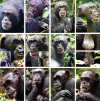Leprosy in wild chimpanzees
- PMID: 34646009
- PMCID: PMC8550970
- DOI: 10.1038/s41586-021-03968-4
Leprosy in wild chimpanzees
Abstract
Humans are considered as the main host for Mycobacterium leprae1, the aetiological agent of leprosy, but spillover has occurred to other mammals that are now maintenance hosts, such as nine-banded armadillos and red squirrels2,3. Although naturally acquired leprosy has also been described in captive nonhuman primates4-7, the exact origins of infection remain unclear. Here we describe leprosy-like lesions in two wild populations of western chimpanzees (Pan troglodytes verus) in Cantanhez National Park, Guinea-Bissau and Taï National Park, Côte d'Ivoire, West Africa. Longitudinal monitoring of both populations revealed the progression of disease symptoms compatible with advanced leprosy. Screening of faecal and necropsy samples confirmed the presence of M. leprae as the causative agent at each site and phylogenomic comparisons with other strains from humans and other animals show that the chimpanzee strains belong to different and rare genotypes (4N/O and 2F). These findings suggest that M. leprae may be circulating in more wild animals than suspected, either as a result of exposure to humans or other unknown environmental sources.
© 2021. The Author(s).
Conflict of interest statement
The authors declare no competing interests.
Figures









Comment in
-
Circulating leprosy in the wild.Nat Rev Microbiol. 2022 Jan;20(1):2. doi: 10.1038/s41579-021-00653-1. Nat Rev Microbiol. 2022. PMID: 34697496 No abstract available.
References
-
- Walker, S. L. et al. in Manson’s Tropical Infectious Diseases 23rd edn, 506–518 (Elsevier, 2014).
-
- Meyers WM, et al. Leprosy in a mangabey monkey–naturally acquired infection. Int. J. Lepr. Mycobact. Other Mycobact. Dis. 1985;53:1–14. - PubMed
Publication types
MeSH terms
LinkOut - more resources
Full Text Sources
Medical

